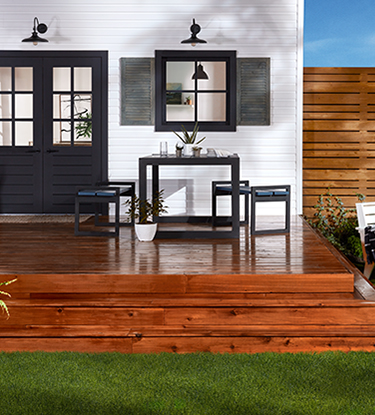Find the Right Deck Stain: Accomplish a Spectacular and Sturdy Deck
Find the Right Deck Stain: Accomplish a Spectacular and Sturdy Deck
Blog Article
A Comprehensive Guide to Different Sorts Of Deck Staining Techniques for Ultimate Defense and Aesthetics
In the realm of deck upkeep, the art of tarnishing stands as a crucial action towards both protecting the integrity of your outdoor room and boosting its aesthetic allure. As we navigate with the elaborate world of deck discoloration methods, one begins to appreciate the nuanced approaches that can make all the difference in between an average coating and a remarkable one.
Comprehending Various Types of Discolorations
Numerous types of stains are typically used in the process of deck staining to accomplish various visual and safety impacts. On the other hand, semi-transparent spots use an equilibrium between color improvement and security, enabling some wood grain to show through.
Furthermore, there are likewise specialized discolorations such as printer toners and sealers. Toners include a tip of color to the wood while providing marginal security, making them ideal for newer decks with much less wear. Sealers, on the various other hand, deal defense against wetness and UV rays without adding color, making them a prominent choice for decks that currently boast a preferable hue. Understanding the characteristics and benefits of each kind of discolor is crucial for achieving the preferred appearance and resilience for your deck.
Choosing the Right Spot Color
When thinking about the visual appeals of your deck staining job, the selection of tarnish shade plays a vital function in improving the safety qualities of the picked stain type (Right Deck Stain). The shade you pick can dramatically impact the total look of your deck, as well as its capacity to endure the elements in time
When selecting a discolor color, it's necessary to consider the existing color pattern of your home's outside. Integrating the deck discolor with the total visual of your property can develop a aesthetically enticing and cohesive exterior space. Additionally, the color of your deck tarnish can influence the temperature level of the deck surface; darker colors have a tendency to take in more warm, while lighter colors reflect sunlight and remain cooler.
Furthermore, the kind of wood you are staining will additionally affect exactly how the stain color shows up. Different wood species can connect with the stain in numerous means, possibly changing the last shade. It's recommended to evaluate the discolor on a tiny, inconspicuous location of the deck to guarantee the shade turns out as desired prior to continuing with the entire job.
Preparing Your Deck for Staining
To make certain a successful and long-lasting deck discoloration project, comprehensive prep work of the deck surface area is crucial. Begin by cleaning the deck extensively to get rid of dirt, grime, mildew, and any type of old tarnish or end up.
Examine the deck for any type of damaged or rotten boards that need to be replaced. Hammer down any sticking out nails and sand any kind of rough locations to make sure a smooth surface area for staining. Inspect for any loose railings or steps that may need tightening or fixing.
Once the deck is clean, completely dry, and in good repair service, consider applying a timber brightener to restore the deck's natural shade and open up the wood pores for better tarnish penetration. Finally, secure any type of close-by plants, furnishings, or surfaces with plastic bed linen before waging the discoloration process. Proper prep work is key to accomplishing a professional-looking surface and taking full advantage of the longevity of your deck stain.
Using Spot With Numerous Methods
For a expert and flawless surface, the approach of using stain plays an essential function in boosting the appearance and resilience of your deck. There are numerous strategies you can use to ensure an effective application of discolor.
It is optimal for detailed areas and reaching between deck boards. Back-brushing after rolling is advised to even out the discolor and function it right into the timber for far better penetration.
Spraying is one more preferred technique, supplying speed and ease of application, particularly for huge deck locations. It is necessary to utilize a high-quality sprayer and bear in mind overspray. Pad applicators provide a smooth and even complete and are suitable for both upright and horizontal surfaces. Whichever strategy you select, guaranteeing proper preparation and following supplier guidelines will certainly aid achieve a resilient and gorgeous tarnish finish on your deck.

Maintaining and Re-staining Your Deck
When it comes to re-staining your deck, the regularity depends on numerous aspects such as the kind of tarnish used, the environment in your area, and how much wear and tear your deck experiences. Usually, it is advised to re-stain your deck every 2-4 years to preserve its protection and aesthetics.
Prior to re-staining, ensure the deck is clean, completely dry, and cost-free of any type of previous tarnish residue. Choose a high-grade tarnish that fits your deck's product and gives the desired degree of Water-Based Stains protection.
Verdict
To conclude, recognizing the different kinds of deck stains, choosing the ideal shade, effectively preparing the deck, applying discolor with various strategies, and re-staining the deck and maintaining are crucial actions for supreme security and aesthetic appeals. By adhering to these actions, you can make sure that your deck stays in top problem for years to come.
Additionally, the shade of your deck stain can affect the temperature level of the deck surface; darker colors have a tendency to soak up more heat, while lighter shades show sunlight and stay cooler.
It's advisable to check the tarnish on a little, inconspicuous location of the deck to guarantee the shade turns out as preferred before proceeding with the whole project.

Report this page